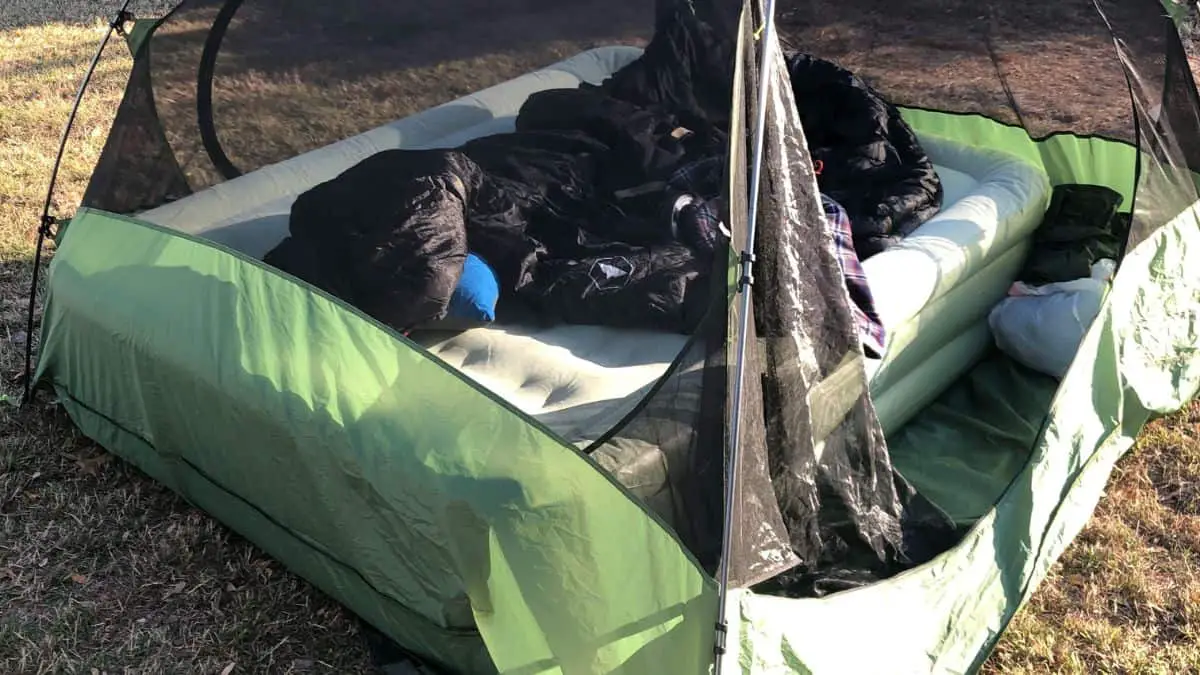Camping Sleeping Pad vs Air Mattress - What's The Best
If you click and purchase with one of our links, we earn a commission. Thanks.

Are you ready to take your camping sleep system to the next level? Choosing the right gear is crucial for a comfortable and restful night’s sleep in the great outdoors. When it comes to deciding between a camping sleeping pad and an air mattress, there are a few factors to consider. Portability, ease of use, cost, comfort, and intended use all play a role in determining the best option for your outdoor sleeping needs. Don’t forget to dress properly for sleeping on a camping trip too.
Camping sleeping pads and air mattresses each have their own advantages and drawbacks. An air mattress offers convenience and comfort, making it a popular choice for car camping trips. On the other hand, a sleeping pad is lightweight and portable, making it ideal for backpacking and wilderness excursions. To help you make an informed decision, let’s take a closer look at the pros and cons of each option.
Key Takeaways:
- Consider portability, ease of use, cost, comfort, and intended use when choosing between a camping sleeping pad and an air mattress.
- An air mattress offers convenience and comfort, making it suitable for car camping.
- A sleeping pad is lightweight and portable, making it ideal for backpacking and wilderness camping.
- Air mattresses provide a more bed-like experience, while sleeping pads offer better insulation.
- Both options have their pros and cons, so choose based on your personal preferences and camping needs.
I started out using an air mattress but moved to sleeping pads when I got into backpacking. But I have learned that when I’m car camping (whether with a tent or actually sleeping in my car), a closed-cell foam pad is a happy medium between the two.
My current favorite foam sleeping pad this one from Teton.
Types of Sleeping Pads

When it comes to choosing the right sleeping pad for your camping adventures, understanding the different types available is key. Here, we will explore the three main types of sleeping pads: self-inflating foam pads, closed-cell foam pads, and manual inflatable pads.
Self-Inflating Foam Pads
Self-inflating foam pads are a popular choice among backpackers due to their lightweight design and comfort. These pads feature open-cell foam that expands and fills with air when the valve is opened. They are easy to inflate and provide excellent insulation from the ground, helping to keep you warm during chilly nights.
Closed-Cell Foam Pads
Closed-cell foam pads are known for their durability and affordability. These pads are made from dense foam that is resistant to moisture and punctures. They are a great option for budget-conscious campers and can withstand rough terrain without losing their insulating properties. However, closed-cell foam pads can be bulkier to carry compared to other types.
Manual Inflatable Pads
Manual inflatable pads offer a balance between comfort and convenience. These pads require manual inflation using a pump or by blowing air into the valve. They are typically made of lightweight materials and provide a cushioned sleeping surface. However, they may be bulkier and less comfortable than self-inflating foam pads.
**Sleeping Pad Type**Self-Inflating Foam PadsClosed-Cell Foam PadsManual Inflatable Pads| **Key Features** | **Pros** | **Cons** |
| Lightweight, comfortable, excellent insulation | - Easy to inflate - Provides insulation from the ground - Lightweight design | - Can be more expensive - May require occasional maintenance |
| Durable, affordable, moisture-resistant | - Budget-friendly option - Resistant to moisture and punctures - Suitable for rough terrain | - Bulkier to carry - Less cushioning compared to other types |
| Convenient, lightweight, cushioned sleeping surface | - Lightweight and portable - Offers cushioned sleeping surface - Manual inflation | - Can be bulkier - Less comfortable than self-inflating foam pads |
Value for Money: Air Mattress vs Sleeping Pad
When considering the value for money, it’s important to compare the cost-effectiveness of an air mattress and a sleeping pad. While both options have their advantages, it ultimately depends on your camping needs and budget.
An air mattress tends to offer more comfort and convenience for its price. It provides a bed-like experience and is suitable for family camping trips where comfort is a priority. Air mattresses come in various sizes and can be adjusted for desired firmness. However, it’s important to note that air mattresses can be bulkier, heavier, and more prone to leaks and punctures, which may require repair or replacement.
On the other hand, sleeping pads, especially foam pads, are more affordable and offer good insulation and portability. They are lightweight and compact, making them ideal for backpacking and wilderness camping. Foam pads provide better insulation by preventing heat loss from the ground, ensuring a warm and comfortable sleep. Although sleeping pads may not offer the same level of comfort as air mattresses, they provide a cost-effective sleeping solution for those who prioritize portability and insulation.
| Air Mattress | Sleeping Pad | |
|---|---|---|
| Comfort | High | Moderate |
| Portability | Lower | Higher |
| Insulation | Lower | Higher |
| Cost | Higher | Lower |
Portability: Air Mattress vs Sleeping Pad

When it comes to choosing the right camping sleep system, portability is a crucial factor to consider. Whether you’re backpacking through the wilderness or embarking on a car camping adventure, the weight and size of your sleeping gear can make a significant difference. In this section, we’ll compare the portability of air mattresses and sleeping pads to help you make an informed decision.
Air Mattress
Air mattresses, while offering comfort and convenience, can be bulkier and heavier compared to sleeping pads. This can be a drawback for backpackers or hikers who are looking to minimize their load and maximize their mobility. Car campers, on the other hand, may find that the bulkiness of air mattresses is not an issue as they don’t have to carry them over long distances.
Sleeping Pad
Sleeping pads, especially compact foam pads, are designed with portability in mind. They are lightweight and can easily be rolled up or folded into a compact size, making them ideal for backpackers and wilderness explorers. These pads can easily fit into your backpack without adding extra weight or taking up too much space.
| Portability | Weight | Size | |
|---|---|---|---|
| Air Mattress | Bulky | Heavier | Larger when deflated |
| Sleeping Pad | Compact | Lightweight | Smaller when rolled up or folded |
As shown in the table, air mattresses are bulkier, heavier, and take up more space when deflated compared to sleeping pads. If portability is a priority for your camping trips, a sleeping pad would be the more suitable choice. However, if you prioritize comfort and don’t mind the additional weight and size, an air mattress may be the right option for you.
Next, we’ll explore the warmth and comfort aspects of air mattresses and sleeping pads to help you further compare these camping sleep systems.
Warmth and Comfort: Air Mattress vs Sleeping Pad
When it comes to choosing between an air mattress and a sleeping pad for your camping sleep system, considering warmth and comfort is essential. Both options have their advantages and considerations to keep in mind.
Insulation and Warmth
When it comes to insulation, sleeping pads, especially foam pads, excel at keeping you warm during chilly nights. The foam acts as a barrier between you and the cold ground, preventing heat loss. This makes sleeping pads a popular choice for backpacking and wilderness camping trips, where staying warm is crucial.
On the other hand, air mattresses may not provide the same level of insulation as sleeping pads. The air inside the mattress can get cold, resulting in heat loss during the night. However, if you’re camping in warmer climates or using the mattress for car camping, the insulation may not be as much of a concern.
Comfort and Cushioning
When it comes to comfort, air mattresses offer a more luxurious sleeping surface. They often come with plush cushioning and ample space to move around. If you prefer a softer sleeping surface that mimics a traditional bed, an air mattress may be the better choice for you.
Sleeping pads, while not as plush as air mattresses, still provide a comfortable sleeping experience. Foam pads conform to your body, providing support and cushioning. While they may not offer the same level of plushness as air mattresses, they can still provide a good night’s sleep during your camping adventures.
| Air Mattress | Sleeping Pad | |
|---|---|---|
| Insulation | May not provide optimal insulation | Offers better insulation, especially foam pads |
| Comfort | Offers a plush and cushioned sleeping surface | Provides comfort and support, but not as plush as air mattresses |
Convenience and Ease of Use: Air Mattress vs Sleeping Pad

When it comes to convenience and ease of use, both air mattresses and sleeping pads offer their own advantages. Air mattresses, particularly those with built-in pumps, provide a quick and effortless inflation process. With just a few presses of a button, you can have a fully inflated mattress ready for use. This makes them an excellent choice for car camping trips, where electricity is readily available.
On the other hand, sleeping pads, especially self-inflating foam pads, are designed to be user-friendly and require minimal setup. They typically come with a valve that allows for easy inflation and deflation. With just a few breaths or rolls, you can have a comfortable sleeping pad ready to use. Additionally, sleeping pads can be conveniently rolled up and packed away without the need for an air pump, making them a practical choice for backpackers and wilderness enthusiasts.
In terms of convenience, it’s important to consider the portability factor as well. Air mattresses tend to be bulkier and heavier compared to sleeping pads, which can be a disadvantage for those looking for a lightweight camping gear. However, if you are not concerned about portability and prioritize comfort and convenience, an air mattress with a built-in pump can provide a hassle-free camping experience.
| Air Mattress | Sleeping Pad | |
|---|---|---|
| Convenience | Quick and effortless inflation with built-in pump | User-friendly design and easy inflation/deflation |
| Comfort | Bulkier and heavier | Lightweight and compact |
| Application | Car camping | Backpacking and wilderness camping |
Pros and Cons: Air Mattress
An air mattress offers several advantages that make it a popular choice for camping sleep systems. Here are the pros and cons to consider:
Pros:
Comfort: Air mattresses provide a plush and cushioned sleeping surface, offering a bed-like experience while camping. Adjustable Firmness: Most air mattresses come with built-in pumps that allow you to adjust the firmness to your preference, ensuring a personalized sleeping experience. Various Sizes: Air mattresses are available in different sizes, including twin, queen, and king, accommodating individuals, couples, or families.
Cons:
Bulkiness: Air mattresses can be bulky and take up significant space when packed, making them less suitable for backpacking or situations where portability is a priority.
Weight: Due to their construction and materials, air mattresses tend to be heavier compared to other camping sleep system options. This can be an inconvenience when carrying them for long distances.
Potential for Leaks and Punctures: Air mattresses are more prone to leaks and punctures, requiring repair or replacement. This can be a hassle and may impact your camping sleep experience if not properly addressed.
Considering these pros and cons will help you determine if an air mattress is the right choice for your camping needs. If comfort and adjustability are essential to you, and you are camping in a car or RV where portability is not a concern, an air mattress can provide a luxurious sleeping surface for a restful night’s sleep.
Table: Pros and Cons of Air Mattress
| Pros | Cons |
|---|---|
| Comfort | Bulkiness |
| Adjustable Firmness | Weight |
| Various Sizes | Potential for Leaks and Punctures |
Pros and Cons: Sleeping Pad
When it comes to choosing a sleeping pad for your camping adventures, there are several pros and cons to consider. Sleeping pads offer many advantages, but they also have some disadvantages that may affect your decision. Let’s take a closer look:
Advantages of Sleeping Pads
- Lightweight and Portable: Sleeping pads are designed to be lightweight and easy to carry, making them ideal for backpacking and wilderness camping.
- Durable: Most sleeping pads are made from durable materials that can withstand rough terrain and regular use.
- Insulation: Sleeping pads provide insulation from the cold ground, helping to keep you warm and comfortable throughout the night.
- Versatile: Sleeping pads can be used in a variety of camping situations, from tents to hammocks, offering flexibility and adaptability.
Disadvantages of Sleeping Pads
- Comfort: While sleeping pads offer cushioning and support, they may not provide the same level of comfort as air mattresses, especially for those who prefer a softer sleeping surface.
- Noisy: Some sleeping pads can make noise when you move around during the night, which may be disruptive to your sleep or the sleep of others in your campsite.
- Thinness: Sleeping pads are typically thinner than air mattresses, which may be a disadvantage for campers who prefer a thicker and more plush sleeping surface.
- Inflation: Unlike air mattresses that can be easily inflated with a pump, some sleeping pads require manual inflation, which may be more time-consuming and labor-intensive.
| Advantages | Disadvantages | |
|---|---|---|
| Lightweight and Portable | X | |
| Durable | X | |
| Insulation | X | |
| Versatile | X | |
| Comfort | X | |
| Noisy | X | |
| Thinness | X | |
| Inflation | X |
##Combining Air Mattress and Sleeping Pad If you’re looking for the ultimate camping comfort, consider combining an air mattress and a sleeping pad. By using both of these camping sleep system essentials, you can create a setup that not only provides cushioning and support but also insulation and added warmth.
When combining an air mattress with a sleeping pad, place the sleeping pad on top of the air mattress. This arrangement allows you to enjoy the plush comfort and spaciousness of the air mattress while benefiting from the insulation and support provided by the sleeping pad.
The combination of an air mattress and a sleeping pad is particularly ideal for those who prioritize a comfortable and cozy sleep while camping. The air mattress offers a soft and cushioned surface, while the sleeping pad adds an extra layer of protection from the cold ground. This combination creates a camping sleep system that maximizes comfort and warmth, ensuring a restful night’s sleep during your outdoor adventures.
Benefits of Combining Air Mattress and Sleeping Pad
- Enhanced comfort with the plushness of an air mattress
- Improved insulation and warmth from the sleeping pad
- Maximum cushioning and support for a restful sleep
Is Combining Air Mattress and Sleeping Pad Right for You?
While combining an air mattress and a sleeping pad offers many benefits, it’s important to consider your specific camping needs and preferences. If you prioritize comfort and are willing to carry the extra weight and bulkiness of both the air mattress and sleeping pad, then this combination can provide you with the ultimate camping sleep system. However, if you value lightweight and compact gear for backpacking or have limited storage space, you may prefer to choose one option over the other.
If you are car camping don’t forget to bring sheets or blankets. They will make the sleeping pad or air mattress warmer and comfortable to sleep on.
I use a fleece blanket as my sheet over my closed foam pad. It is more comfortable to sleep on. I can also wrap myself up in the blanket if I need more warmth than what my sleeping bag provides.
FAQ
What factors should I consider when choosing between a camping sleeping pad and an air mattress?
Factors to consider include portability, ease of use, cost, comfort, and intended use.
What are the different types of sleeping pads?
The main types of sleeping pads are self-inflating foam pads, closed-cell foam pads, and manual inflatable pads.
Which sleeping pad type is best for backpacking?
Self-inflating foam pads are popular among backpackers due to their lightweight design and comfort.
Are air mattresses more comfortable than sleeping pads?
Air mattresses provide a more plush and bed-like sleeping surface, while sleeping pads offer better insulation to keep you warm.
Are sleeping pads more portable than air mattresses?
Yes, sleeping pads are designed to be lightweight and compact, making them easier to carry and pack for backpacking trips.
Can air mattresses be used for backpacking?
Air mattresses are bulkier and heavier, making them less suitable for backpacking, but they are a comfortable option for car camping.
How easy are air mattresses and sleeping pads to set up?
Air mattresses with built-in pumps can be quickly inflated, while self-inflating foam pads are easy to use and require minimal setup.
Do air mattresses have any disadvantages?
Air mattresses can be bulky, heavy, and prone to leaks or punctures, requiring repair or replacement.
Are sleeping pads more affordable than air mattresses?
Yes, especially foam pads, which are a more cost-effective option for camping.
Can I combine an air mattress and a sleeping pad for maximum comfort?
Yes, placing a sleeping pad on top of an air mattress can provide both comfort and insulation for an ultimate camping sleep system.
How do I choose the best camping sleep system?
The choice between an air mattress and a sleeping pad depends on your specific needs and preferences, considering factors such as portability, comfort, warmth, convenience, and intended use.